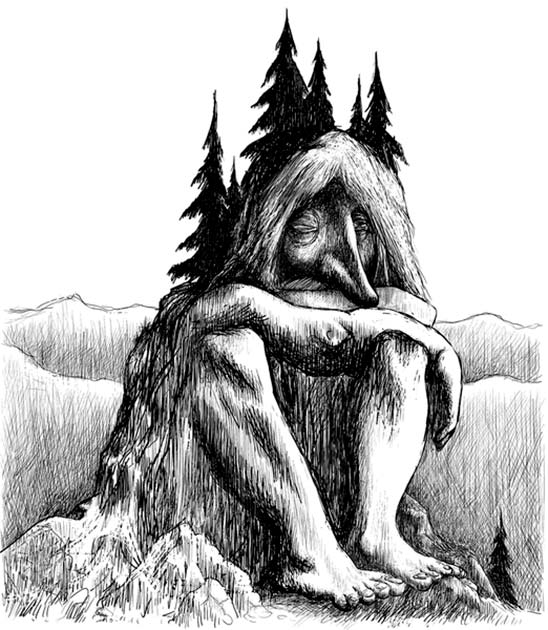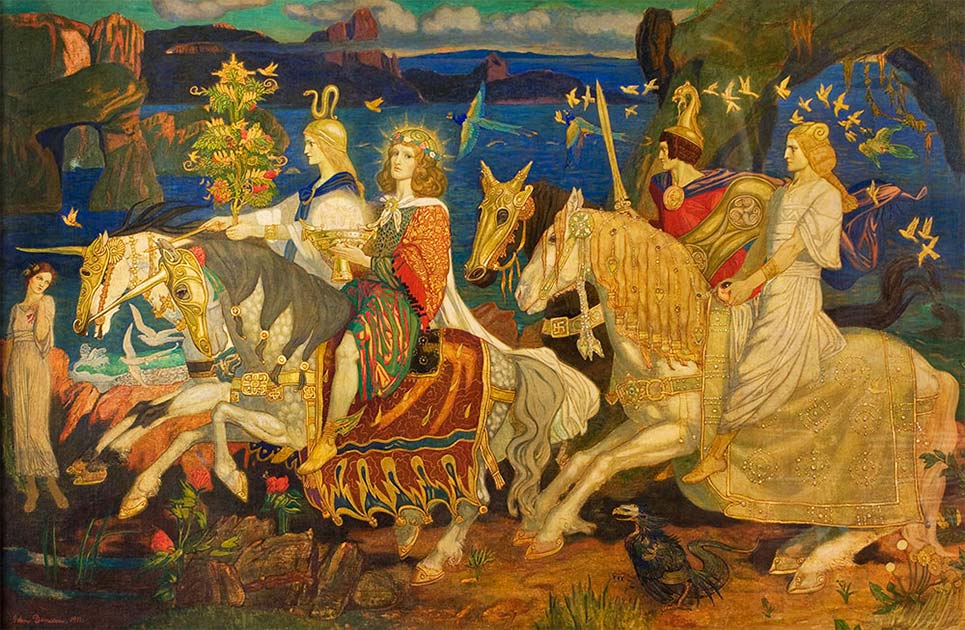Irish mythology can be deeply frustrating. On the one hand, we know comparatively little about the people and their beliefs: we have no Romans to document who they were, and what other evidence we have is scarce. On the other hand, what does survive hints of a mythos both rich and unusual.
We know something of their gods and heroes. But we also know of the Fomorians, also known as the Fomori, a mythical and supernatural race in Irish mythology who are usually depicted as being monstrous and vicious creatures.
They were originally said to have come from the sea or underneath the earth. Later rumors claimed that they were sea raiders and giants. The Fomori are the great rivals of Ireland’s first settlers and of the Tuatha De Danann, the other mythical race in Irish mythology.
Despite this, the two races are recorded as having offspring with each other. The Tuath De Danann would eventually manage to defeat the Fomorians in the Battle of Mag Tuired.
This mythical saga following the Fomori bears many similarities to other Indo-European myths of war. Examples include the Norse mythological war of the Aesir and Vanir and the Olympians and Titans in Greek Mythology.

Some researchers claim that the Fomorians were supernatural people who represented the destructive power of nature and the wild. They were the personification of all of the dangers such as chaos, death, blight, drought, and darkness.
Origins
In order to trace the history of the Fomori name, one must go back through the Old and Middle Irish lexicon. They are typically referred to as the Fomoire or the Fomoiri when referred to as a plural.
Sometimes, the term for a singular would be a Fomoir. Additionally, and most commonly in Middle Irish, they are referred to as Fomoraig in the plural and a Fomorach in the singular. In the Lebor Bretnach (Irish Nennius) written in the 11th century, the Fomori are Latinized and referred to as Muiridi.
- Manannán mac Lir: The Otherworldly God of Irish Myth
- The Abhartach: The Irish Walking Dead and the Origin of Dracula?
There has been much debate around the etymology of the name. The first part of the name is mostly agreed upon by scholars. In Old Irish “fo”, can be translated to the under, below, lower, and beneath.
Unfortunately, the next part of the word becomes more difficult to translate. One suggestion is that “mur” in the Old Irish can be translated to sea. Thus, the term for the Formori is undersea people. The origin of this etymology is what is agreed by some of the medieval writers.
A further development came later which claimed that “mor” meant great/big and thus their name would be the great under(world) ones or the Underworld Giants. A modern theory, followed by scholars, is that the name comes from a hypothetical old Irish term for a phantom or a demon.
This comes from the Morrigan, an old Irish mythological figure, and the antiquated English word mare (as in nightmare). This would fit, translating the name again as something like the underworld demons or phantoms.
The very first stories of the Fomori do indeed regard them as malevolent spirits that lived underwater and in the nether regions of the earth. One of the earliest mentions of the Fomori, dating from the 7th century from an elegy for Mess-Telmann, they are said to live under the world of men. Later on, they were described as sea raiders which was likely influenced by the real-life Viking raids on Ireland that dominated in the 6th, 7th, and 8th centuries.
Usually, the Fomori are described as monstrous looking. In some stories, the Fomori have the body of a man with the head of a goat. This is how they were described in the Lebor na hUidre (the Book of the Dun Cow).
Other times they are described as only having one eye, one arm, and one leg. However, those Fomorians are usually the ones with the Tuath De. These are Elatha and his son Bres. Interestingly, these people were described as darkly beautiful.
The Fomorians are usually depicted as the enemies of the Tuath De as they are completely contrasting characters. As well as this, the Fomori are the rivals of Ireland’s first settlers. However, many sources say that there was an overlap between the Fomorians and Tuath De. Interestingly they are both presided over by the figure of Tetra.

The conflict that raged between the Fomorians and the Tuath De bears an incredible resemblance to other mythological conflicts. As mentioned previously, the similarity in the stories can be seen in the Vanir and the Aesir, the Olympians and the Titans but also in the Ancient Hinduism Vedic mythology between the Devas and Asuras. It has been posited that the Tuath De learning agricultural skills and knowledge is similar to the other cultures where the defeated races are representative of the fertility of the soil.
Myths
One of the most prevalent myths surrounding the Fomorians comes from the myth of Partholon in which he and his people are the first to invade Ireland after a flood. However, the Fomorians were already there.
- The Banshee: Celtic Messengers of Death
- Icelanders and the Huldufolk: A Nation Gripped by its Legends
They had arrived two hundred years earlier and lived off fish and fowl. This was until Partholon arrived with the plow and oxen. Partholon managed to defeat the Fomorians, but his people soon were killed by a plague.
The next people to arrive were Nemed and his people. Supposedly they arrived 30 years after the death of Patholon’s people. Nemed also encountered the Fomorians when they arrived.
However, in this myth, the Fomorians were seafarers from the Middle East who descended from Noah. Nemed proved to be successful in fighting the Fomorians but when Nemed died, the Fomorian Kings of Conand and Morc enslaved his people, demanding heavy tributes of grain, cattle, and children.
A huge battle followed an uprising from the remaining people of Nemed which cost both sides dearly. The war was only stopped by a flood that drowned many people.
One of the final battles that the Fomori would face was against the Tuatha De. The Tuatha De were supposed to be the gods of the Goidellic Irish people. The Tuatha De defeated the Fomorians and claimed possession of Ireland after the battle of Mag Tuired.
However, the Fomorians were not completely defeated. One of the earliest Tuath De kings was claimed to be the half-Fomorian Bres, and it was this that finally brought peace between the two supernatural peoples.
Top Image: Very few physical descriptions of the Fomori survive apart from their being giants, which has led to all sorts of strange interpretations like this from 1912. Source: John Duncan / Public Domain.
By Kurt Readman